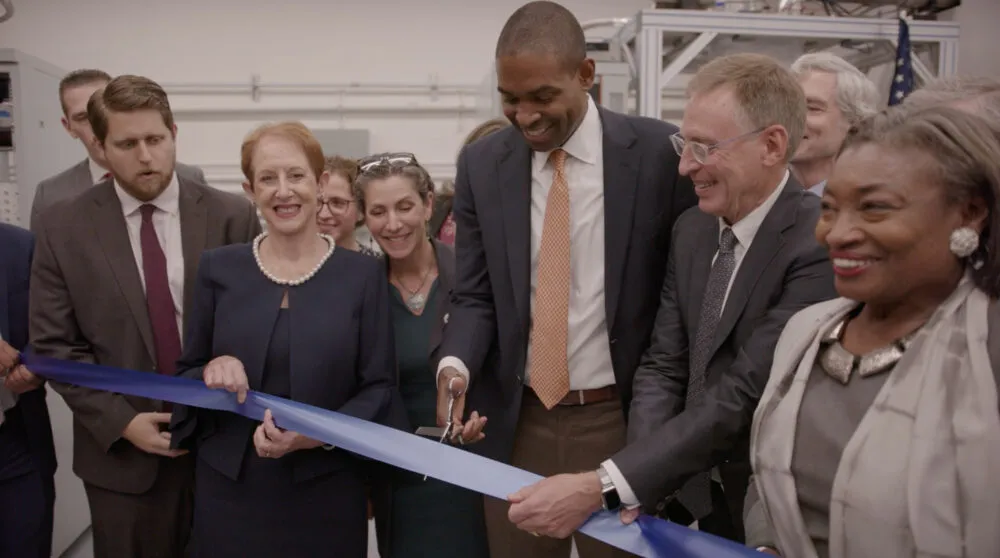Spotlight
|
April 24, 2023
Building a pipeline for diverse talent in STEM careers
Credit: New York Genome Center/John Abbott
The New York Genome Center (NYGC) is the first large-scale genomic sequencing center in New York City and home to JLABS’ 30,000 square-foot life sciences incubator. In 2012, the Partnership Fund’s foundation invested $5 million in NYGC to help establish New York as an international center for genomic research. Today, NYGC is known as a world-class hub for genome sequencing, analytics, bioinformatics, high-performance computing, and translational research.
Recently, NYGC launched a summer internship program with the goal of developing a pipeline of diverse talent in life sciences. The eight-week internship provides undergraduate students from around the country with mentorship and hands-on work experience in life sciences, with a particular focus on engaging students from under-represented backgrounds in STEM. We spoke with the team at NYGC to learn more.
This interview has been edited for length and clarity.
What does the New York Genome Center do?
The New York Genome Center (NYGC) is an independent research organization founded in 2011 and convened by 11 institutional founding members, including every major medical school, hospital, and laboratory throughout New York City. NYGC was built on the notion that the pace of scientific discovery in the genomic sciences will increase if we take a multi-institutional and multi-disciplinary approach.
Our greatest areas of expertise are in whole genome sequencing, genomic analysis, computational biology, and the discovery of novel biomedical models. We also have experience in technological innovation and the development of new computational methods, with a faculty expert in many facets of genomic science.
New York wasn’t considered a leader in life sciences for a long time, and now that reputation has changed. Why is genomic research in New York City important?
When the NYGC’s Evnin Family Scientific Director, Chief Executive Officer and founder, Tom Maniatis, PhD, moved from Boston to New York City, he immediately asked, “Where is New York’s genome center? How could there not be one in New York?” It was clear to him that genomic research needed to be here, so he set out to create the Genome Center.
Health equity and diversity are a part of the NYGC’s core values. So, one of the most important reasons genomic research needs to be done in New York is because the diversity here reflects the world’s diversity, and, ultimately, that needs to be reflected in genomic science.
The datasets that typically define genomic science are largely of European descent, significantly under-representing non-European minorities. These are the same databases that are then used to help discover, for example, new therapeutics or drug targets. And since diseases can present very differently across ethnic and racial divides, we felt it was crucial to democratize genomic science by creating an open-source database and datasets that would better reflect the world as it is and not be predominated by white and European samples.
NYGC has also been working to fill gaps in diverse representation in the STEM workforce. How has NYGC’s commitment to equity and inclusion translated into building a diverse pipeline for people pursuing careers in life sciences?
In 2021, we launched an eight-week summer internship program for undergraduate students in STEM, led by our Diversity, Equity and Inclusion Advisory Group, which was keen on helping create a pipeline of diverse talent in the life sciences.
We’ve had interns at NYGC for many years. In the past, we’ve partnered with LifeSci NYC and the S. Jay Levy Fellowship for Future Leaders, a program for high-achieving students at the City College of New York, to source qualified local candidates. For our current internship program, we wanted to broaden our outreach and help more students from traditionally under-represented groups in STEM. To do that, we reach out to undergraduate sciences departments at several universities with diverse student bodies, including HBCUs and CUNY schools across the five boroughs. In doing so, we’ve received an overwhelming number of resumes.
We accept applications on a rolling basis, and we’re already getting a great response. There’s also been a positive response from the universities and students, thanking us for including them in our search. So, we’re heading in the right direction. We plan to expand the program to 12 interns, up from nine positions last year.
How is the program designed and what experience do the students gain during the internship?
We focus on helping our interns explore different career paths in science. Many students don’t know all the available options in science, from attending graduate schools to becoming a faculty member, a science writer, a staff scientist, a computational biologist, a program manager, working on a grants team, or going into the business side of science — there are all sorts of things you can do as a scientist.
With that in mind, we designed our intern program with a bigger-picture approach. We assign one to two interns to various teams within our organization, such as faculty labs, production sequencing lab, project management, software engineering, bioinformatics, and accounting.
Similar to last year’s program, this year we plan to have a mix of scientific presentations, soft-skill building, and career-focused sessions for our interns. We’re planning to hold workshops focused on introductions to genomics and working in an academic lab, resume writing, and career panels.
Our NYGC mentors are thrilled to have the internship program expanded. Many of our mentors are also honing their management, mentorship and leadership skills, so it’s a great opportunity for all involved.
These internships are paid positions. We recognized that a lack of access to paid work experience could be a barrier to entry into STEM careers. More economically advantaged students may be able to accept unpaid internships, whereas other students can’t afford to. Real-world work and leadership experience can make all the difference when these students enter the workforce, so NYGC has invested in this program so that we can offer a paid internship that helps level the playing field for more students from economically diverse backgrounds to remain competitive.
What have been the results and what does success look like for the NYGC intern program?
We’re very proud of our program. The feedback from last year’s cohort has been positive, which shows that we’re making an impact. Many of our interns commented that they learned new computational skills, and one intern wrote that they became more comfortable asking questions about unfamiliar topics and engaging with new information. That alone is a success for us and a highlight of the program — getting a young person to want to know more and to feel comfortable asking questions.
Ultimately, our hope for the program is to have a pipeline of diverse talent for NYGC and the broader scientific community in the future. In fact, we recently hired a former intern from Baruch College who was interested in science and research development. That’s always an exciting outcome for us. But seeing more diverse students go into scientific careers, in general, would be an equally outstanding achievement for our program. We would love to see what success our interns go on to have and to play even a small part in that lets us know that we’ve been able to make an impact.
What does the future look like for life sciences in New York City?
It’s robust. We know our city and state have both, very explicitly and with a lot of dollars, echoed our commitment to ensure that life sciences is one of our leading economic sectors, and that is a point of pride for us as well. As our internship program grows, we embrace the opportunity to cultivate new talent with various backgrounds, life experiences, and perspectives.
When NYGC launched in 2011, the Partnership Fund’s investment came at a critical time when fewer venture capital dollars were available for life sciences in New York City. That VC landscape has greatly improved over the last decade. Also, the amount of life sciences real estate available in New York City indicates a massive increase in the amount of space available today compared to 10 years ago. The trend is very positive, and we believe New York City has a bright and exciting future in life sciences.



